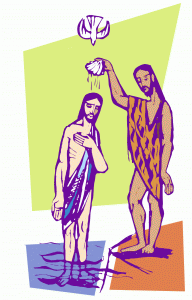Luke 3:15-17, 21-22
This text is used for the Lectionary Year C on January 10, 2016.
 When I was becoming acquainted with the lectionary for the first time, I was under the assumption that Epiphany was a season in the same way that Lent and Advent were. I think I had even heard about the theological purpose of Epiphany: it is the season when Christ is unveiled. Eventually my Episcopal friends would gently correct me, pointing out that it is instead the first instance of ordinary time. Still I don’t think that description, wherever I got it from, is half bad. Think about what comes to us in Epiphany in Year C: a baptism, a party, an epic sermon, Jesus’ dedication and the transfiguration. If Mary had put together a scrapbook, it would probably look like Epiphany.
When I was becoming acquainted with the lectionary for the first time, I was under the assumption that Epiphany was a season in the same way that Lent and Advent were. I think I had even heard about the theological purpose of Epiphany: it is the season when Christ is unveiled. Eventually my Episcopal friends would gently correct me, pointing out that it is instead the first instance of ordinary time. Still I don’t think that description, wherever I got it from, is half bad. Think about what comes to us in Epiphany in Year C: a baptism, a party, an epic sermon, Jesus’ dedication and the transfiguration. If Mary had put together a scrapbook, it would probably look like Epiphany.
‘Ordinary’ seems like an inept description. This timeline is filled with one extraordinary event after another. With this in mind, it might surprise you that I find the bookends of the season extremely difficult to preach. Every year the sun rises and falls on the season after Epiphany with Jesus’ baptism and his transfiguration. After about three years, I found I didn’t have anything left to say. So what do preachers do with Jesus’ baptism?

